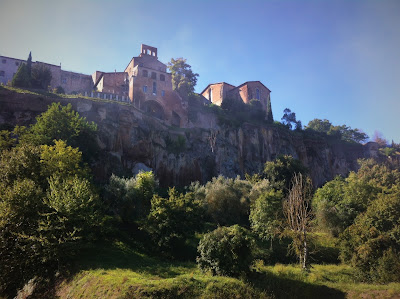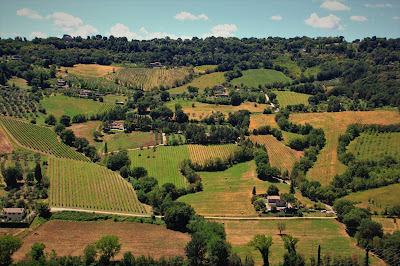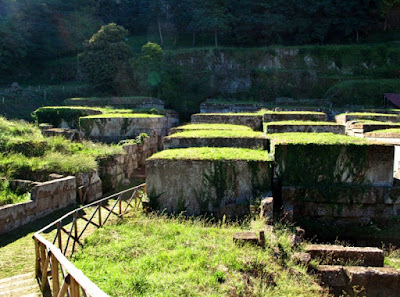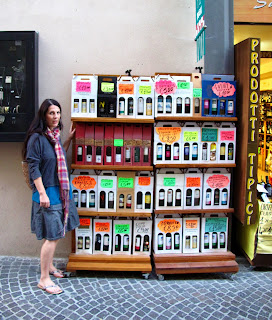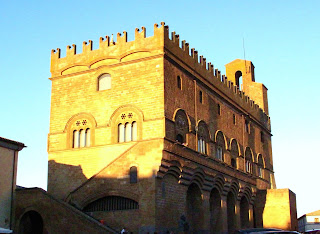Set amidst a rolling landscape and surrounded by vineyards, Orvieto perches regally atop a rock outcrop 1000 feet above the valley floor...
Founded by the Etruscans around 500 BCE, Orvieto is thought by many archeologists to be the mysterious city of Velzna, a huge Etruscan city destroyed by the Romans. Later, when the Romans annexed the Etruscans, Orvieto became a major Roman stronghold because of its virtually impenetrable verticle cliffs. Orvieto became a refuge for the Pope and a castle during the Middle Ages. Many grand palaces and churches were built.
Today Orvieto, with its close proximity to the A1 Autostrada connecting Rome with Florence, has become quite the weekend destination for those escaping the big cities and a day-trip destination for foreign tourists. While this gorgeously preserved Medieval hilltop town can be explored in one day, the real magic of Orvieto occurs at sunset when the crowds disperse, and the residents unwind.
If you ride the funicular up to the old center, you are deposited at Piazza Cahen. There is an info centre here at the funicular station where you can get an Orvieto map and find information on various tours of the Orvieto Underground. The ruins of Rocca Albornoziana, a fortress from the mid-12th century, are to the left of Piazza Cahen. The view from here of the Umbrian countryside is outstanding. To your right are a public park, and beyond it, the remains of an ancient Etruscan Temple on the edge of the bluffs with more breathtaking views.
St. Patricks Well
Towards the belvedere of the Etruscan temple remains is one of the most impressive feats of engineering in 16th century Italy; St. Patricks well. The Pozo di San Patrizio was built in 1527 by pope Clement while he stayed in Orvieto during the sack of Rome. The Pope knew the cliff walls of Orvieto would keep invaders at bay, but if they wanted to outlast an extended siege, the city would need an ample water supply. The well took only ten years to build and has a central shaft reaching down 53 metres (175 feet), and two separate paths spiral around the well. One path leads downwards, and the other spiral upwards so that mules carrying water only had one-way traffic to deal with. It's a fun workout to descend the 250 steps down, and the 70 windows offer those with slight claustrophobia some relief. The cost is €5, and the well is open 9-8. The audio guide is worth the €2 rental; bring a sweater-it's cold at the bottom!
Orvieto Cathedral
Orvieto Underground
If you want more subterranean tours, The Well of The Cave (Pozzo della Cava) is a vast network of underground caverns, tunnels and wells dating back to the Roman and Etruscan civilizations of Orvieto. The tunnels provide an excellent exploring adventure for kids but are not for the claustrophobic! Self-guided tours are €4/€2.50 for children. For more information, visit pozzodellacava.it
Etruscan Tombs
There are two Etruscan burial sites at the base of Orvieto's cliff. Called a Necropolis, these are literally cities of the dead where the burial tombs look like miniature stone houses laid out in a city grid plan. On the Southside of Orvieto is the Necropolis of Cannicella, and to the North of the town is the Necropoli Etrusca del Crocifisso del Tufo. This is the one I chose to visit because it had a large free parking lot and a small museum holding some of the archeological findings from the area. You can wander freely amongst the tombs that date back to the 5th century BCE and even go inside some of them. You can even see the Etruscan family name carved in stone above the tomb entrance. Tickets €3; closed Mondays & Tuesdays.
Orvieto Wine & Wine Tasting
Orvieto is known for its delicious white wines, appropriately named Orvieto Classico. A blend of 40% Grechetto, 20-40% Trebbiano (locally called Procanico) and up to 40% of other white grape blends such as Verdello and Malvasia Bianco. Orvieto Classico is a DOC wine is a pale straw colour that is light and crisp, with a delicate floral taste. There are many enoteca 0r wine bars to try different local wine varieties, including Orvieto "secco" or dry white. Another fun thing to do is tour a local vineyard and have a wine tasting. You can arrange this with the local Tourist Information Centre near the funicular station in Piazza Cahen or visit the tourist office online at orvietoviva.com to plan your tour. For more on discovering wines of Umbria, don't miss my popular blog post 7 Wines To Try In Umbria
Civita di Bagnoregio
A short 20km from Orvieto is the well-preserved Medieval village of Civita di Bagnoregio. Considered a ghost town, Civita di Bagnoregio is nicknamed "The Dying Town" because of the gradual slide of its' perch atop a clay pillar into the steep valley below. Civita is connected by a 1 km pedestrian toll bridge crossing the canyon. It costs €5 to cross the bridge to Civita, which pays for the shoring up of the village's hillside. Stepping through the city gates is like stepping back through the mists of time; Renaissance, Medieval, Roman and Etruscan architecture blend together, becoming a fun scavenger hunt. The leisurely pace of life in Civita de Bagnoregio reminds one to slow down and enjoy the moment. Busses from Orvieto to Civita de Bagnoregio leave several times a day; check the orvietoviva.com site for the seasonal schedule. Also, check out my blog post on Civita di Bagnoregio for more information on what to see and do.
Orvieto is a place I stop to visit again and again. What is your favourite memory of Orvieto? The food, the wine, the architecture?

